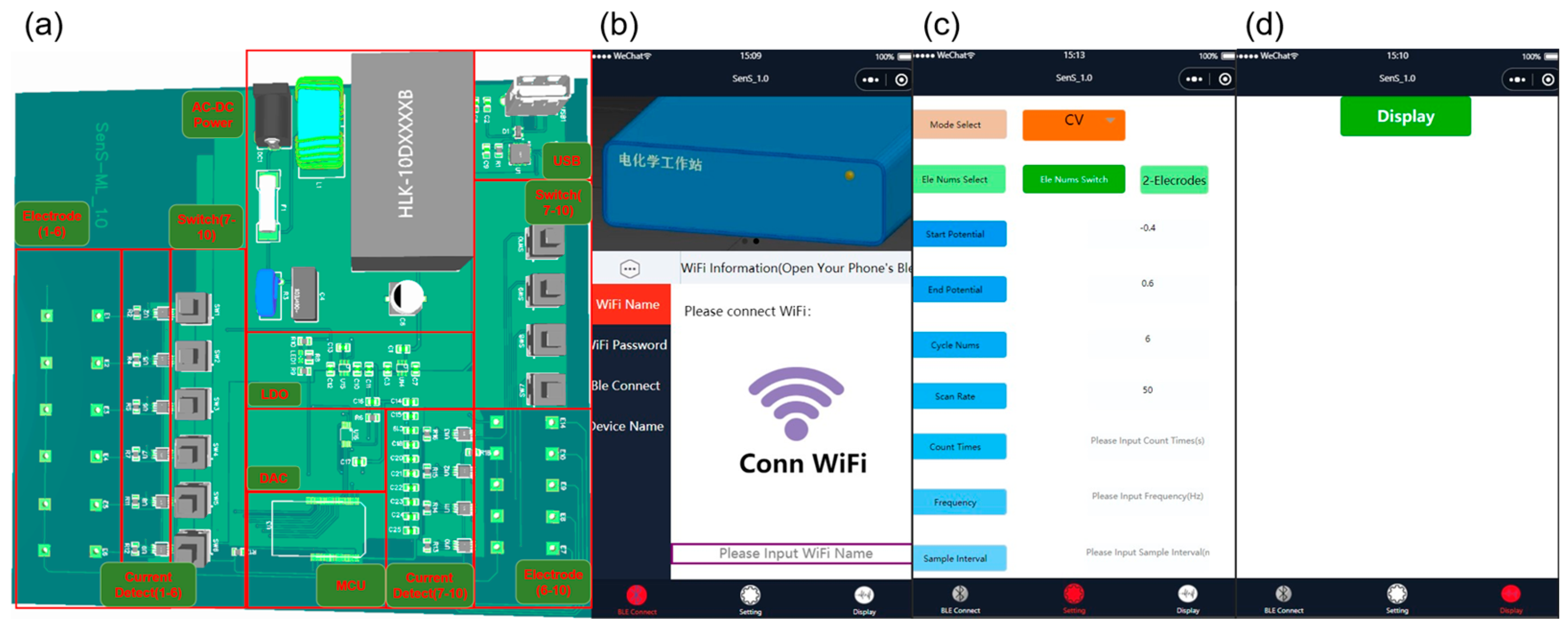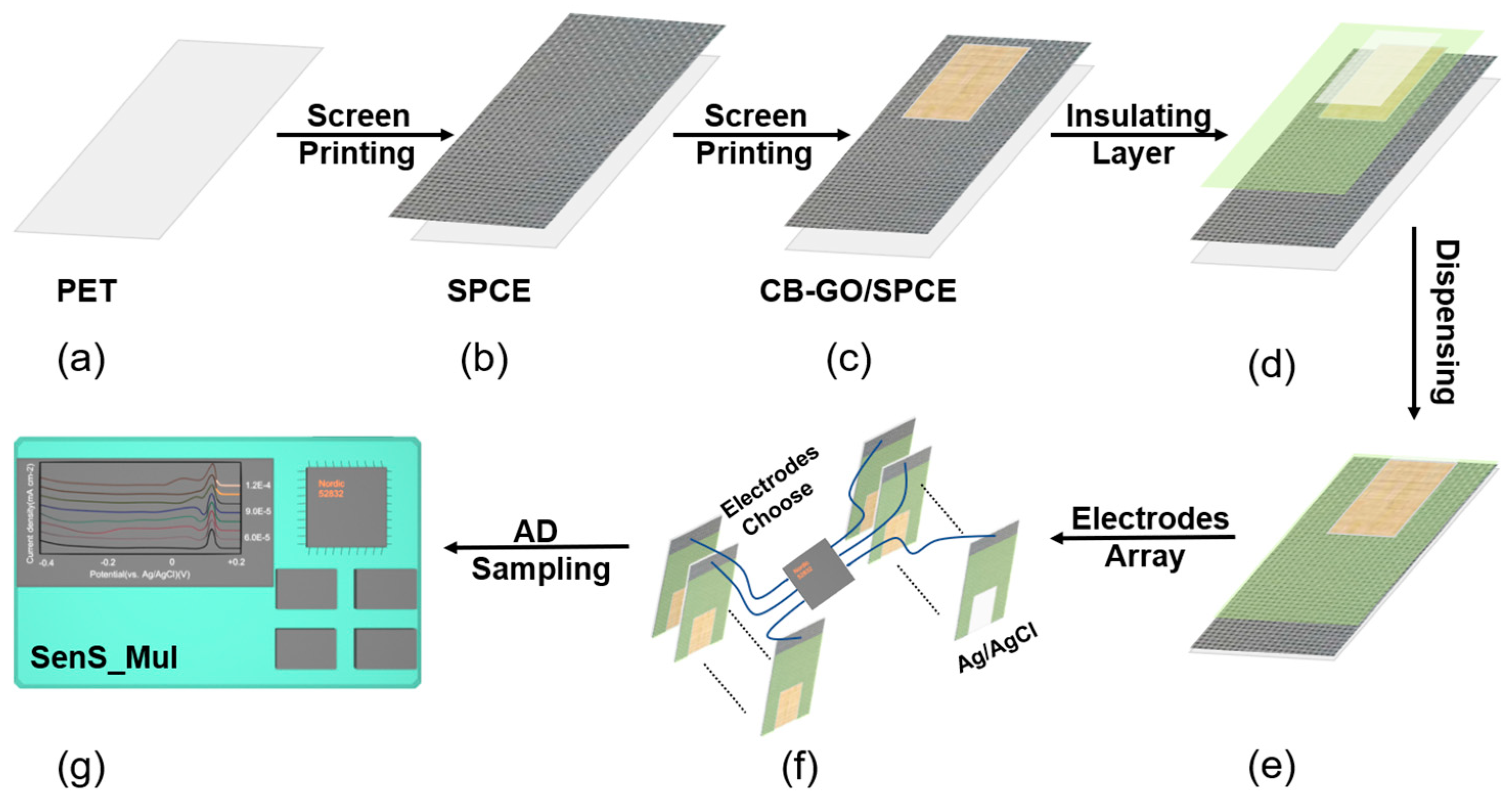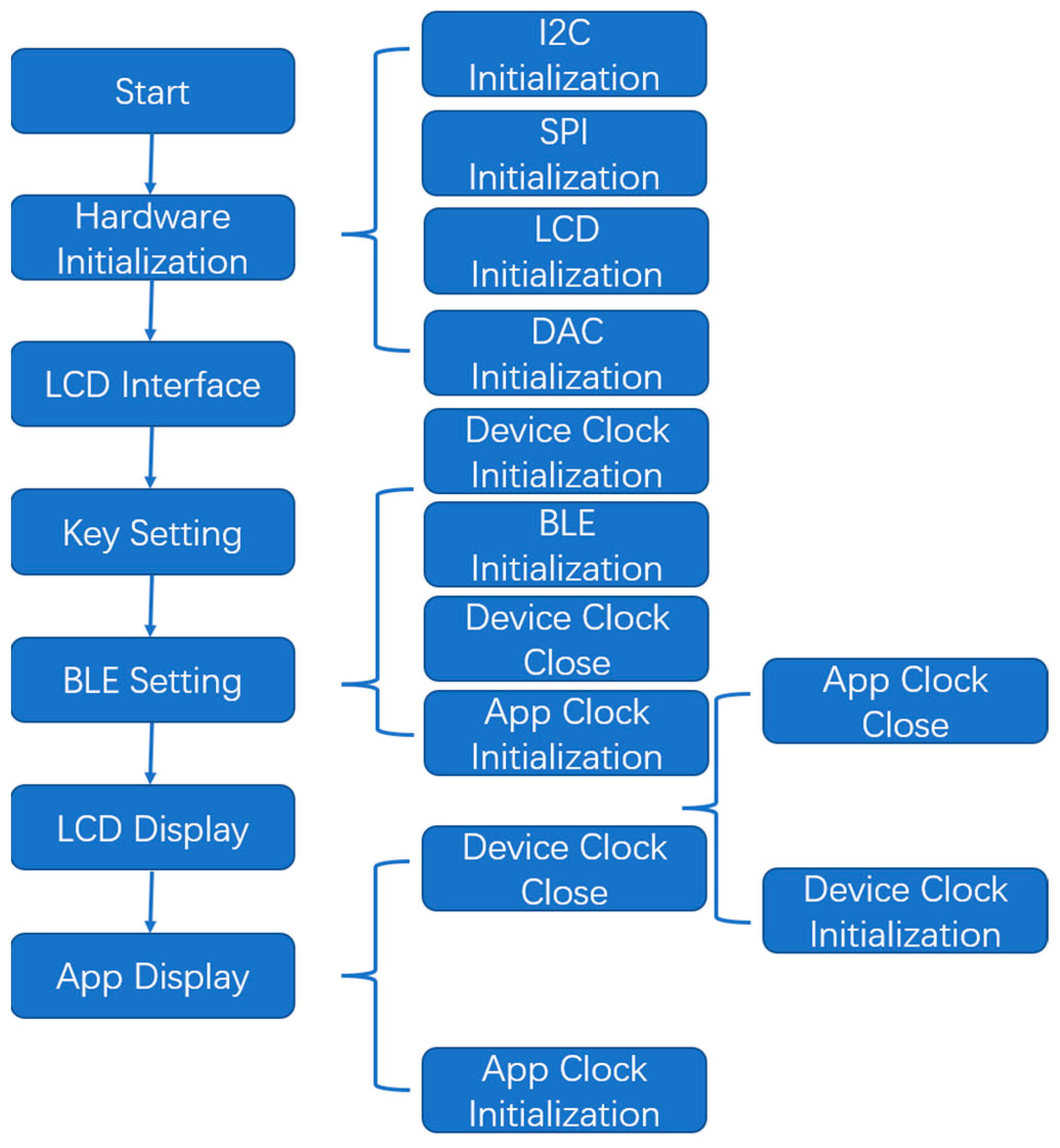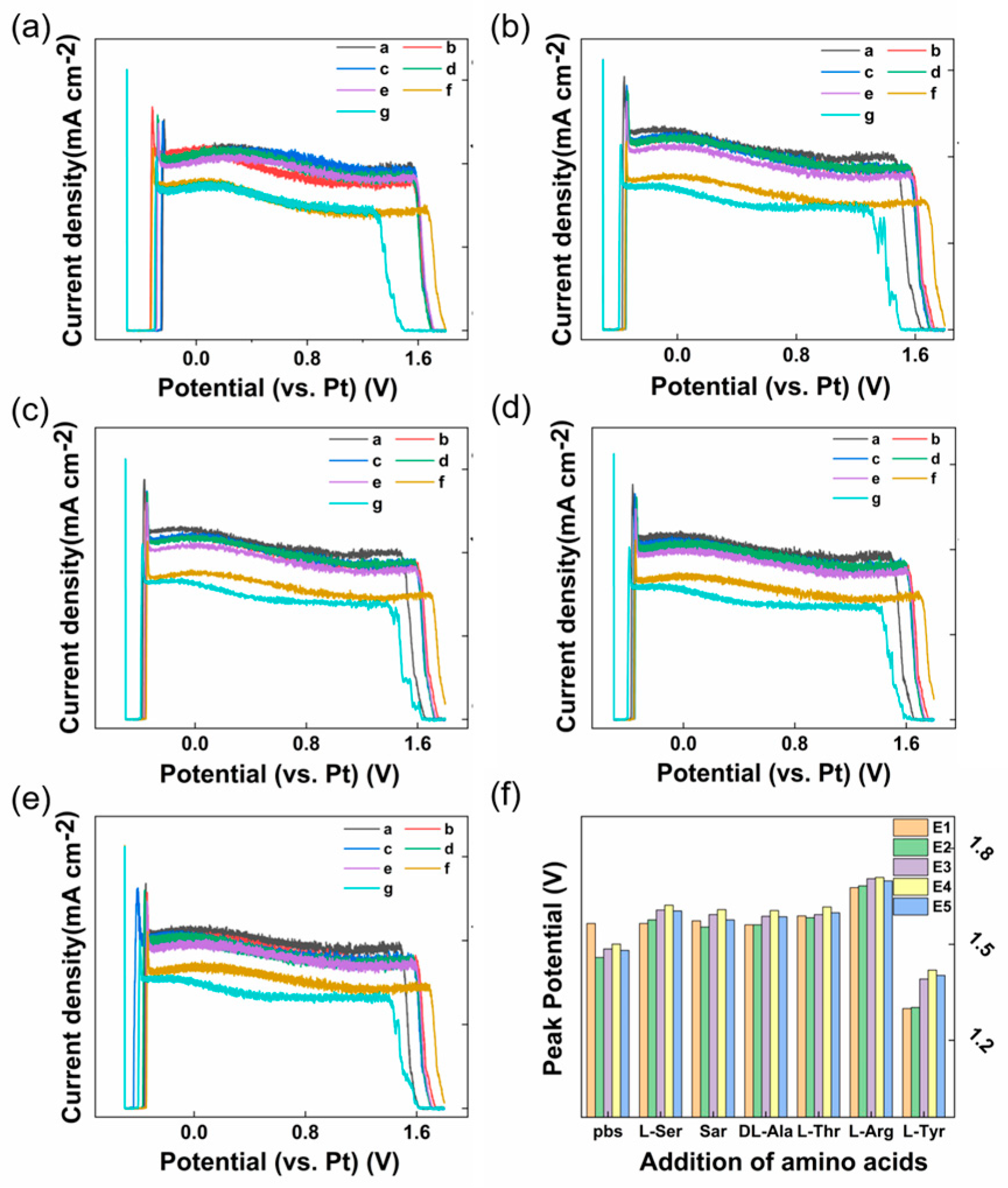A Time-Division Multiplexing Multi-Channel Micro-Electrochemical Workstation with Carbon-Based Material Electrodes for Online L-Trosine Detection
Abstract
1. Introduction
2. Materials and Methods
2.1. Design of Time-Division Multiplexing (TDM) Portable Electrochemical Workstation System
2.2. Chemical and Apparatus
2.3. Chemical Modification of the Nafion/CB-GO/SPCE
2.4. Software Design Process
2.5. The Workstation Equipped with the Nafion/CB-GO/SPCE for Tyr Detection
3. Results
3.1. Characterization of the Tyr Sensor
3.2. The Reliability and Specificity of the Nafion/CB-GO/SPCE
3.3. Technical Parameters of Multi-Channel Electrochemical Workstation
3.4. Potential Applications
4. Conclusions
Supplementary Materials
Author Contributions
Funding
Institutional Review Board Statement
Informed Consent Statement
Data Availability Statement
Acknowledgments
Conflicts of Interest
References
- Dasarathy, B.V. Sensor fusion potential exploitation-Innovative architectures and illustrative applications. Proc. IEEE 1997, 85, 24–38. [Google Scholar] [CrossRef]
- Hu, X.B.; Liu, Y.L.; Wang, W.J.; Zhang, H.W.; Qin, Y.; Guo, S.; Zhang, X.W.; Fu, L.; Huang, W.H. Biomimetic Graphene-Based 3D Scaffold for Long-Term Cell Culture and Real-Time Electrochemical Monitoring. Anal. Chem. 2018, 90, 1136–1141. [Google Scholar] [CrossRef]
- Ng, E.; Le, A.K.; Nguyen, M.H.; Wang, S.X. Early Multiplexed Detection of Cirrhosis using Giant Magnetoresistive Biosensors with Protein Biomarkers. ACS Sens. 2020, 5, 3049–3057. [Google Scholar] [CrossRef] [PubMed]
- Yao, C.Y.; Ng, E.; Wang, S.X. An automated and mobile magnetoresistive biosensor system for early hepatocellular carcinoma diagnosis. Biosens. Bioelectron. 2022, 202, 113982. [Google Scholar] [CrossRef] [PubMed]
- Hung, S.C.; Lu, C.C.; Chen, L.C. A Highly Selective and Interference-Resistive Opto-Mechatronic Sensor for Fast Detection of Nickel Ions. IEEE Sens. J. 2021, 21, 23949–23956. [Google Scholar] [CrossRef]
- Chen, L.L.; Huang, J.; Liu, Y.H. Hand-Eye Calibration Technology of Intelligent Picking Robot Using Multiple Photoelectric Sensor Information Fusion. J. Nanoelectron. Optoelectron. 2021, 16, 1348–1356. [Google Scholar] [CrossRef]
- Lv, G.S.; Wang, H.T.; Tong, Y.H.; Dong, L.; Zhao, X.L.; Zhao, P.F.; Tang, Q.X.; Liu, Y.C. Flexible, Conformable Organic Semiconductor Proximity Sensor Array for Electronic Skin. Adv. Mater. Interfaces 2020, 7, 2000306. [Google Scholar] [CrossRef]
- Ji, S.; Jang, J.; Hwang, J.C.; Lee, Y.; Lee, J.H.; Park, J.U. Amorphous Oxide Semiconductor Transistors with Air Dielectrics for Transparent and Wearable Pressure Sensor Arrays. Adv. Mater. Technol. 2020, 5, 1900928. [Google Scholar] [CrossRef]
- Bao, Q.W.; Li, G.; Yang, Z.C.; Pan, P.; Liu, J.; Chang, J.Y.; Wei, J.; Lin, L. Electrochemical performance of a three-layer electrode based on Bi nanoparticles, multi-walled carbon nanotube composites for simultaneous Hg(II) and Cu(II) detection. Chin. Chem. Lett. 2020, 31, 2752–2756. [Google Scholar] [CrossRef]
- Bao, Q.W.; Li, G.; Yang, Z.C.; Pan, P.; Liu, J.; Li, R.R.; Wei, J.; Hu, W.; Cheng, W.B.; Lin, L. In situ detection of heavy metal ions in sewage with screen-printed electrode-based portable electrochemical sensors. Analyst 2021, 146, 5610–5618. [Google Scholar] [CrossRef]
- Umapathi, R.; Ghoreishian, S.M.; Sonwal, S.; Rani, G.M.; Huh, Y.S. Portable electrochemical sensing methodologies for on-site detection of pesticide residues in fruits and vegetables. Coord. Chem. Rev. 2022, 453, 214305. [Google Scholar] [CrossRef]
- Zhu, W.X.; Zhang, Y.; Gong, J.D.; Ma, Y.Y.; Sun, J.; Lo, T.; Wang, J.L. Surface Engineering of Carbon Fiber Paper toward Exceptionally High-Performance and Stable Electrochemical Nitrite Sensing. ACS Sens. 2019, 4, 2980–2987. [Google Scholar] [CrossRef] [PubMed]
- Li, S.J.; Ma, Q. Electrochemical nano-sensing interface for exosomes analysis and cancer diagnosis. Biosens. Bioelectron. 2022, 214, 114554. [Google Scholar] [CrossRef] [PubMed]
- Cao, X.Y.; Xu, J.Y.; Xia, J.F.; Zhang, F.F.; Wang, Z.H. An electrochemical aptasensor based on the conversion of liquid-phase colorimetric assay into electrochemical analysis for sensitive detection of lysozyme. Sens. Actuators B-Chem. 2018, 255, 2136–2142. [Google Scholar] [CrossRef]
- Tajik, S.; Beitollahi, H.; Nejad, F.G.; Zhang, K.Q.; Le, Q.V.; Jang, H.W.; Kim, S.Y.; Shokouhimehr, M. Recent Advances in Electrochemical Sensors and Biosensors for Detecting Bisphenol A. Sensors 2020, 20, 3364. [Google Scholar] [CrossRef]
- Banga, I.; Paul, A.; Muthukumar, S.; Prasad, S. Characterization of Room-Temperature Ionic Liquids to Study the Electrochemical Activity of Nitro Compounds. Sensors 2020, 20, 1124. [Google Scholar] [CrossRef]
- Lin, S.Y.; Wang, B.; Zhao, Y.C.; Shih, R.; Cheng, X.B.; Yu, W.Z.; Hojaiji, H.; Lin, H.S.; Hoffman, C.; Ly, D.; et al. Natural Perspiration Sampling and in Situ Electrochemical Analysis with Hydrogel Micropatches for User-Identifiable and Wireless Chemo/Biosensing. ACS Sens. 2020, 5, 93–102. [Google Scholar] [CrossRef]
- Xu, G.; Cheng, C.; Liu, Z.Y.; Yuan, W.; Wu, X.Z.; Lu, Y.L.; Low, S.S.; Liu, J.L.; Zhu, L.H.; Ji, D.Z.; et al. Battery-Free and Wireless Epidermal Electrochemical System with All-Printed Stretchable Electrode Array for Multiplexed In Situ Sweat Analysis. Adv. Mater. Technol. 2019, 4, 1800658. [Google Scholar] [CrossRef]
- Shah, A.Z. L-tryptophan modified glassy carbon electrode for the picomolar detection of As(III). J. Electrochem. Soc. 2020, 167, 117509. [Google Scholar] [CrossRef]
- Nithya, S.; Dutta, A. Superior dual mode electrochemical sensing of NH3 using Ni2+ doped CuO anode with lanthanum gallate based electrolyte. Sens. Actuators B-Chem. 2022, 361, 131731. [Google Scholar] [CrossRef]
- Chen, C.; Tsow, F.; Campbell, K.D.; Iglesias, R.; Forzani, E.; Tao, N.J. A wireless hybrid chemical sensor for detection of environmental volatile organic compounds. IEEE Sens. J. 2013, 13, 1748–1755. [Google Scholar] [CrossRef]
- Ghafar-Zadeh, E. Wireless Integrated Biosensors for Point-of-Care Diagnostic Applications. Sensors 2015, 15, 3236–3261. [Google Scholar] [CrossRef]
- Kim, J.; Imani, S.; de Araujo, W.R.; Warchall, J.; Valdes-Ramirez, G.; Paixao, T.; Mercier, P.P.; Wang, J. Wearable salivary uric acid mouthguard biosensor with integrated wireless electronics. Biosens. Bioelectron. 2015, 74, 1061–1068. [Google Scholar] [CrossRef]
- Sohrabi, H.; Majidi, M.R.; Nami, F.; Asadpour-Zeynali, K.; Khataee, A.; Mokhtarzadeh, A. A novel engineered label-free Zn-based MOF/CMC/AuNPs electrochemical genosensor for highly sensitive determination of Haemophilus Influenzae in human plasma samples. Microchim. Acta 2021, 188, 100. [Google Scholar] [CrossRef] [PubMed]
- Cao, J.; Sun, T.; Grattan, K.T.V. Gold nanorod-based localized surface plasmon resonance biosensors: A review. Sens. Actuators B-Chem. 2014, 195, 332–351. [Google Scholar] [CrossRef]
- Sohrabi, H.; Khataee, A.; Ghasemzadeh, S.; Majidi, M.R.; Orooji, Y. Layer double hydroxides (LDHs)-based electrochemical and optical sensing assessments for quantification and identification of heavy metals in water and environment samples: A review of status and prospects. Trends Environ. Anal. Chem. 2021, 31, e00139. [Google Scholar] [CrossRef]
- Mirzaee, R.; Soltani, R.D.C.; Khataee, A.; Boczkaj, G. Combination of air-dispersion cathode with sacrificial iron anode generating Fe2+Fe3+2O4 nanostructures to degrade paracetamol under ultrasonic irradiation. J. Mol. Liq. 2019, 284, 536–546. [Google Scholar] [CrossRef]
- Zhao, J.; Cong, L.R.; Ding, Z.Y.; Zhu, X.J.; Zhang, Y.F.; Li, S.H.; Liu, J.; Chen, X.; Hou, H.B.; Fan, Z.; et al. Enantioselective electrochemical sensor of tyrosine isomers based on macroporous carbon embedded with sulfato-beta-Cyclodextrin. Microchem. J. 2020, 159, 105469. [Google Scholar] [CrossRef]
- Fooladi, E.; Razavizadeh, B.M.; Noori, M.; Kakooei, S. Application of carboxylic acid-functionalized of graphene oxide for electrochemical simultaneous determination of tryptophan and tyrosine in milk. SN Appl. Sci. 2020, 2. [Google Scholar] [CrossRef]
- Wang, S.Q.; Zhai, H.Y.; Chen, Z.G.; Wang, H.H.; Tan, X.C.; Sun, G.H.; Zhou, Q. Constructing a Sensitive Electrochemical Sensor for Tyrosine Based on Graphene Oxide-epsilon-MnO2 Microspheres/Chitosan Modified Activated Glassy Carbon Electrode. J. Electrochem. Soc. 2017, 164, B758–B766. [Google Scholar] [CrossRef]
- Hassanvand, Z.; Jalali, F. Simultaneous determination of L-DOPA, L-tyrosine and uric acid by cysteic acid-modified glassy carbon electrode. Mater. Sci. Eng. C-Mater. Biol. Appl. 2019, 98, 496–502. [Google Scholar] [CrossRef] [PubMed]
- Swathy, S.; Mathew, M.R.; Kumar, K.G. Poly L- methionine/Electrochemically Reduced Graphene Oxide Composite Film Modified Glassy Carbon Electrode for the Simultaneous Determination of 5-hydroxyindole Acetic Acid and Tyrosine. J. Electrochem. Soc. 2022, 169, 087519. [Google Scholar] [CrossRef]
- Atta, N.F.; Galal, A.; Ahmed, Y.M. Highly Conductive Crown Ether/Ionic Liquid Crystal-Carbon Nanotubes Composite Based Electrochemical Sensor for Chiral Recognition of Tyrosine Enantiomers. J. Electrochem. Soc. 2019, 166, B623–B630. [Google Scholar] [CrossRef]
- Krishnan, R.G.; Saraswathyamma, B. Simultaneous Resolution and Electrochemical Quantification of Tyrosine and Tryptophan at a Poly (Diphenylamine) Modified Electrode. J. Electrochem. Soc. 2021, 168, 027509. [Google Scholar] [CrossRef]





| Components | Cost ($) | Components | Cost ($) |
|---|---|---|---|
| USB chip (CP2102-GMR) | 1.8 | power module (MAX9934FAUA+) | 2.75 |
| USB connector (USB-101) | 0.1 | CP-032HPJCT-ND (DC_JACK_0.7MM) | 0.8 |
| 576-1259-1-ND (LDO-MIC5205-3.3YM5-TR) | 0.72 | 576-1259-1-ND (LDO-MIC5205-3.3YM5-TR) | 0.36 |
| AD5667RBRMZ-2-ND | 9.08 | Resistance and capacitance | 0.059 |
| AD8608ARUZ | 4 | PCB | 0.5 |
| MAX4643EUA+ | 1.2 | 3D-printing module | 0.78 |
| MAX4644EUT+T | 2.37 | LCD | 4.31 |
| MK-02A (nRF-52832) | 3 | Connection terminals | 0.05 |
| COMMON MODE FILTER (PDMCAT18107) | 0.7 | piezoresistor (10D561K) | 0.1 |
| Push Button Switch (BTSA) | 0.08 | power module (HLK-10M05) | 3.2 |
| Cost ($) | 53.51 | ||
| This Work | Versa STAT 4 | CompactStat.h | PalmSens | Interface 1010B | |
|---|---|---|---|---|---|
| Channels | 10 | 1 | 1 | 1 | 1 |
| Voltage Range | ±3 V (67 μV resolution) 40 μV noise | ±10 V (6 μV resolution) ±0.2% of reading ± 2 mV | ±10 V (0.4 μV resolution) 16/40 nV | ±10 V (76.3 μV resolution) ≤0.1% ± 1 mV offset | ±12 V (1 μV resolution) ±0.3% of reading ±1 mV |
| Techniques | OP, CA, CV, DPV, SWV, LSV, NPV | POT, CA, CV, DPV, SWV, OCPT, CPI, LSV | POT, CA, CV, DPV, SWV, LSV, EIS | CA, CV, DPV, SWV, LSV, CC, ZRA, LSP | POT, CA, CV, DPV, SWV |
| Current Range | 1 range: ±180 μA (6.4 nA resolution) 30 nA noise | 10 range: ±2 A (120 fA resolution) ±5 pA ± 0.3% | 6 range: ±10 A (1.5 p0A resolution) 0.15 fA | 9 range: ±10 mA (5 fA resolution) ≤0.1% (at Full Scale Range) | 9 range: ±1 A (1.5 pA resolution) ±0.2% of reading, ±0.2% of range 4 nA: <0.5% ± 20 pA |
| Power source | AC power or USB | AC power | USB | Rechargeable Battery | AC power |
| Connectivity to Mobile Phones | Wireless connection via Bluetooth Low Energy | NA | WIFI | Wireless connection via Bluetooth | NA |
| Cost (USD) | 53.51 | 61,880 | 23,205 | 9282 | 38,650 |
Disclaimer/Publisher’s Note: The statements, opinions and data contained in all publications are solely those of the individual author(s) and contributor(s) and not of MDPI and/or the editor(s). MDPI and/or the editor(s) disclaim responsibility for any injury to people or property resulting from any ideas, methods, instructions or products referred to in the content. |
© 2023 by the authors. Licensee MDPI, Basel, Switzerland. This article is an open access article distributed under the terms and conditions of the Creative Commons Attribution (CC BY) license (https://creativecommons.org/licenses/by/4.0/).
Share and Cite
Bao, Q.; Li, G.; Yang, Z.; Wei, J.; Cheng, W.; Qu, Z.; Lin, L. A Time-Division Multiplexing Multi-Channel Micro-Electrochemical Workstation with Carbon-Based Material Electrodes for Online L-Trosine Detection. Sensors 2023, 23, 6252. https://doi.org/10.3390/s23146252
Bao Q, Li G, Yang Z, Wei J, Cheng W, Qu Z, Lin L. A Time-Division Multiplexing Multi-Channel Micro-Electrochemical Workstation with Carbon-Based Material Electrodes for Online L-Trosine Detection. Sensors. 2023; 23(14):6252. https://doi.org/10.3390/s23146252
Chicago/Turabian StyleBao, Qiwen, Gang Li, Zhengchun Yang, Jun Wei, Wenbo Cheng, Zilian Qu, and Ling Lin. 2023. "A Time-Division Multiplexing Multi-Channel Micro-Electrochemical Workstation with Carbon-Based Material Electrodes for Online L-Trosine Detection" Sensors 23, no. 14: 6252. https://doi.org/10.3390/s23146252
APA StyleBao, Q., Li, G., Yang, Z., Wei, J., Cheng, W., Qu, Z., & Lin, L. (2023). A Time-Division Multiplexing Multi-Channel Micro-Electrochemical Workstation with Carbon-Based Material Electrodes for Online L-Trosine Detection. Sensors, 23(14), 6252. https://doi.org/10.3390/s23146252







